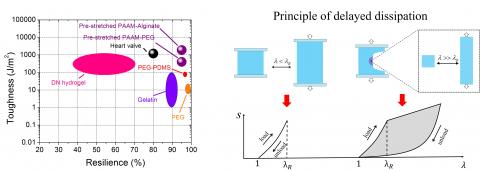Presenter:
Shaoting Lin
Abstract:
Hydrogels have applications as diverse as scaffolds for tissue engineering, vehicles for drug delivery, actuators for optics and fluidics, and model extracellular matrices for biological studies. The scope of hydrogel’s applications, however, is often severely limited by their mechanical behavior. For example, injury and disease of load-bearing tissues such as articular cartilages and spine disks have huge impacts on both millions of peoples’ wellbeing and a multi-billion-dollar biomaterial industry, posing critical healthcare challenge to our aging society. However, since most synthetic hydrogels are mechanically weak and brittle, current replacements for injured or diseased load-bearing tissues have to rely on metals and rigid plastics, sacrificing hydrogels’ bioactivity and flexibility for mechanical robustness. Inspired by the mechanics and structures of tough biological tissues, we propose that a general principle for the design of tough hydrogels is to implement two mechanisms for dissipating mechanical energy and maintaining high elasticity in hydrogels [1-4]. A particularly promising strategy for the design is to integrate multiple pairs of mechanisms across multiple length scales ranging from nanometers to millimeters into a hydrogel [2,4]. Guided by our theoretical model and design principle, we develop a new hydrogel system with extremely high toughness as well as capability of stem-cell encapsulation. Applications of the tough and bioactive hydrogels will be further discussed, for example, by 3D printing them into various prototypes for tissue regeneration [4]. Reference [1]. J. Sun et al, Nature, 489, 133 (2012) [2]. X. Zhao, Soft Matter, 10, 672 (2014) [3]. I. Liao et al, Advanced Functional Materials, 47, 5833 (2013) [4]. S. Lin et al, Soft Matter, In press (2014)
